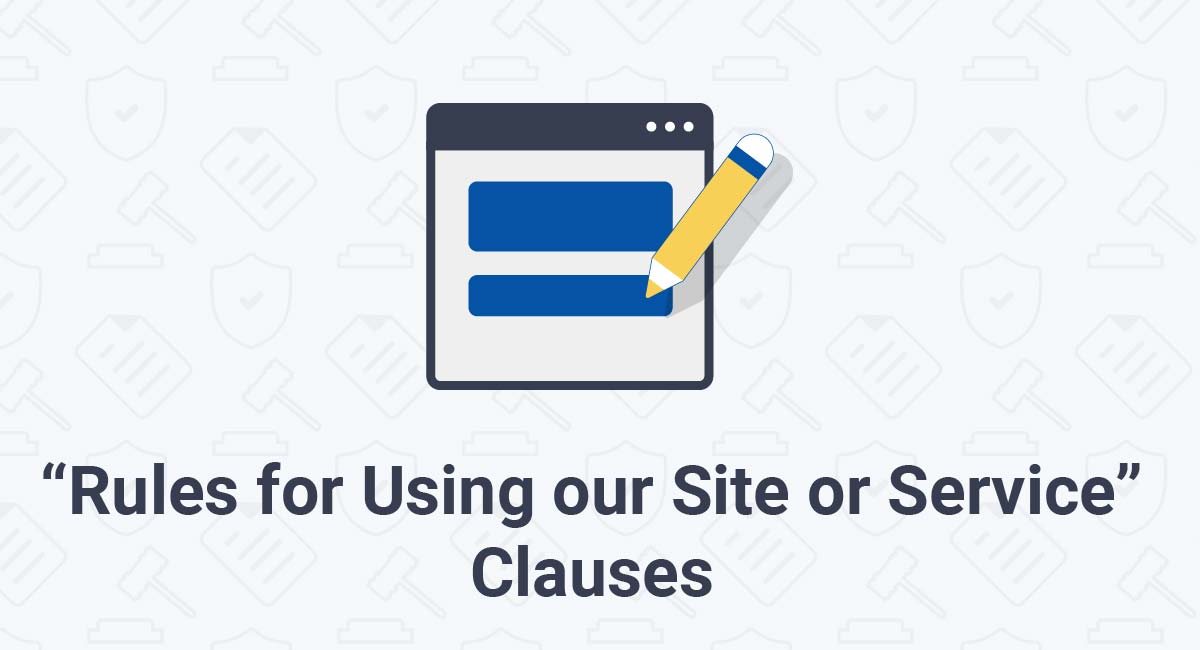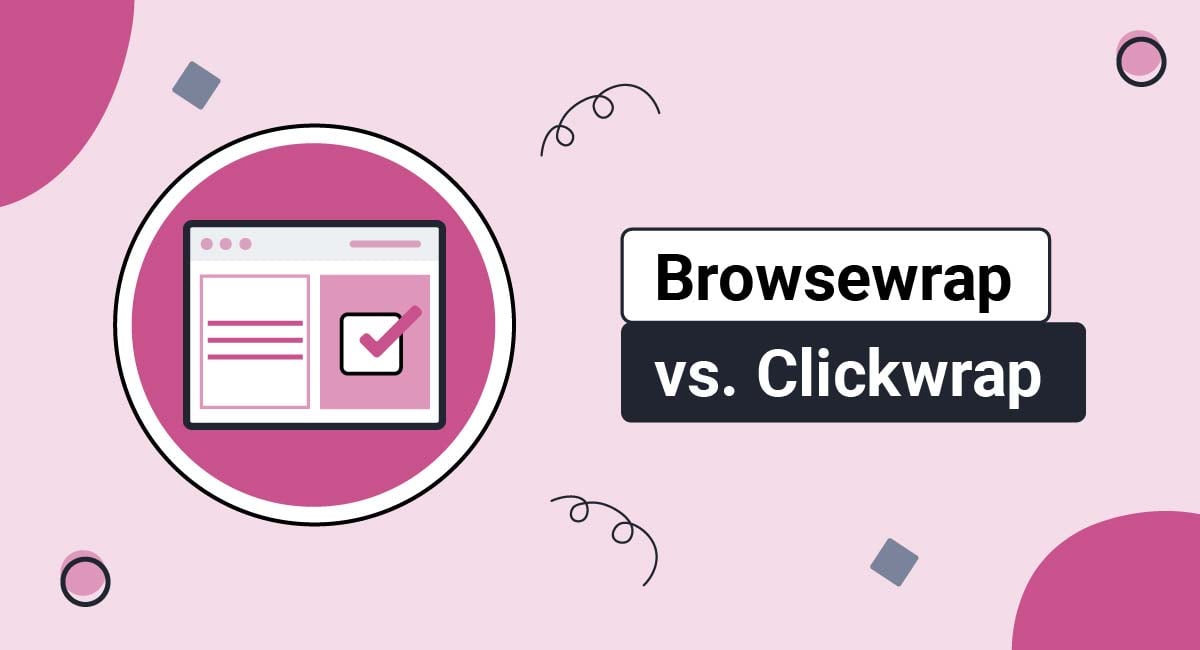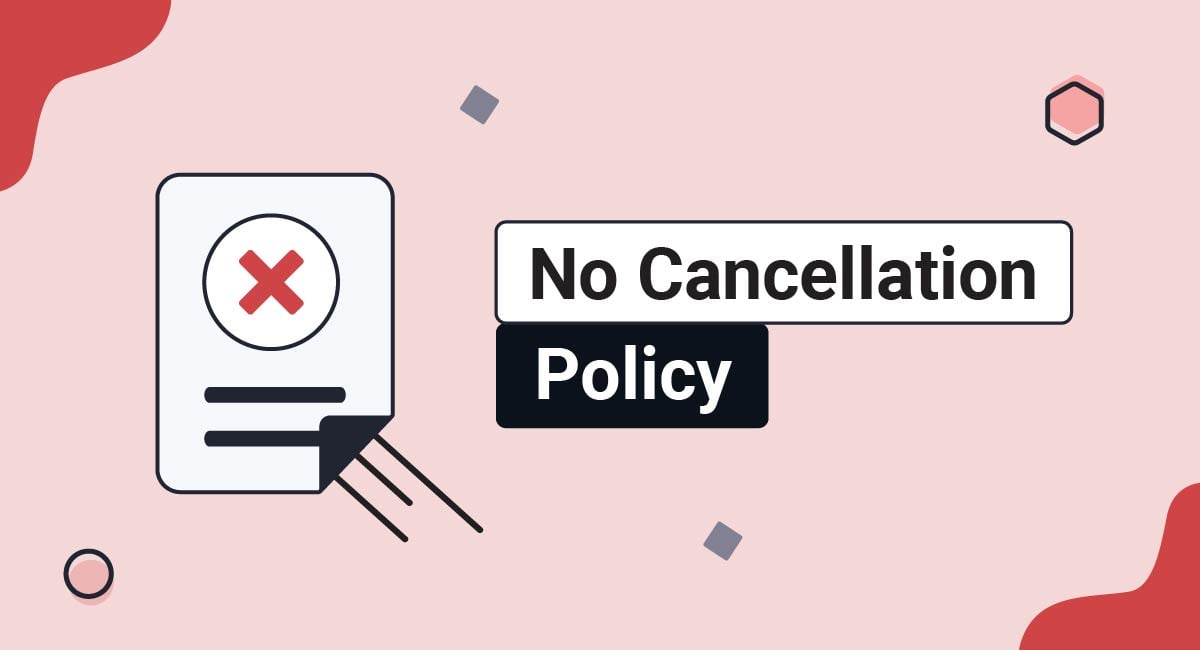While a Terms and Conditions agreement isn't a legal requirement for your website, we strongly recommend having one to protect your website, your service, and your users.
A Terms and Conditions agreement is especially useful for clearly and unequivocally setting out the rules for using your website or platform, by inserting a "Rules for Using our Site or Service" ("Rules of Use") clause. Sometimes a Terms and Conditions agreement is also known as a Terms of Use agreement.
Our Terms and Conditions Generator makes it easy to create a Terms and Conditions agreement for your business. Just follow these steps:
-
At Step 1, select the Website option or the App option or both.
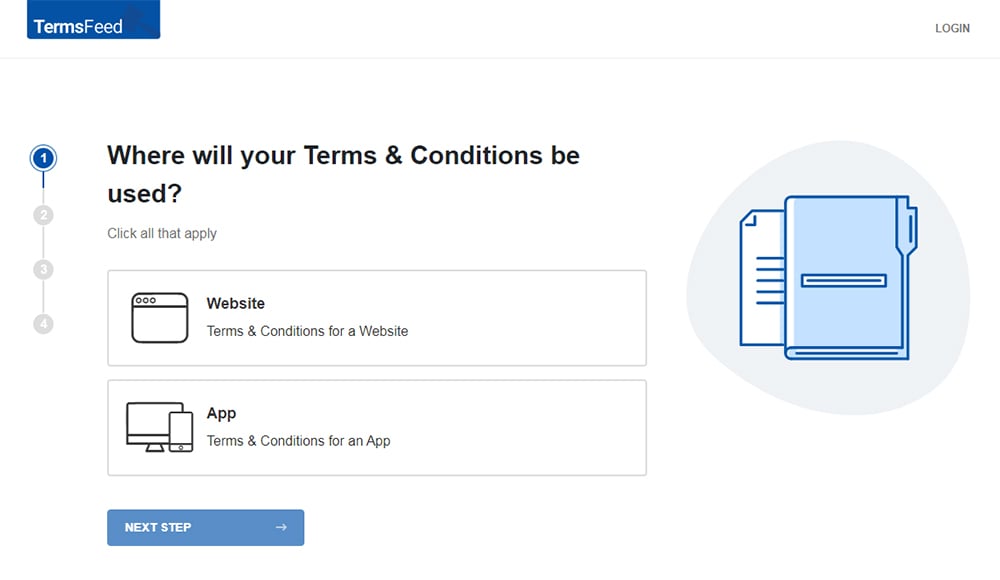
-
Answer some questions about your website or app.
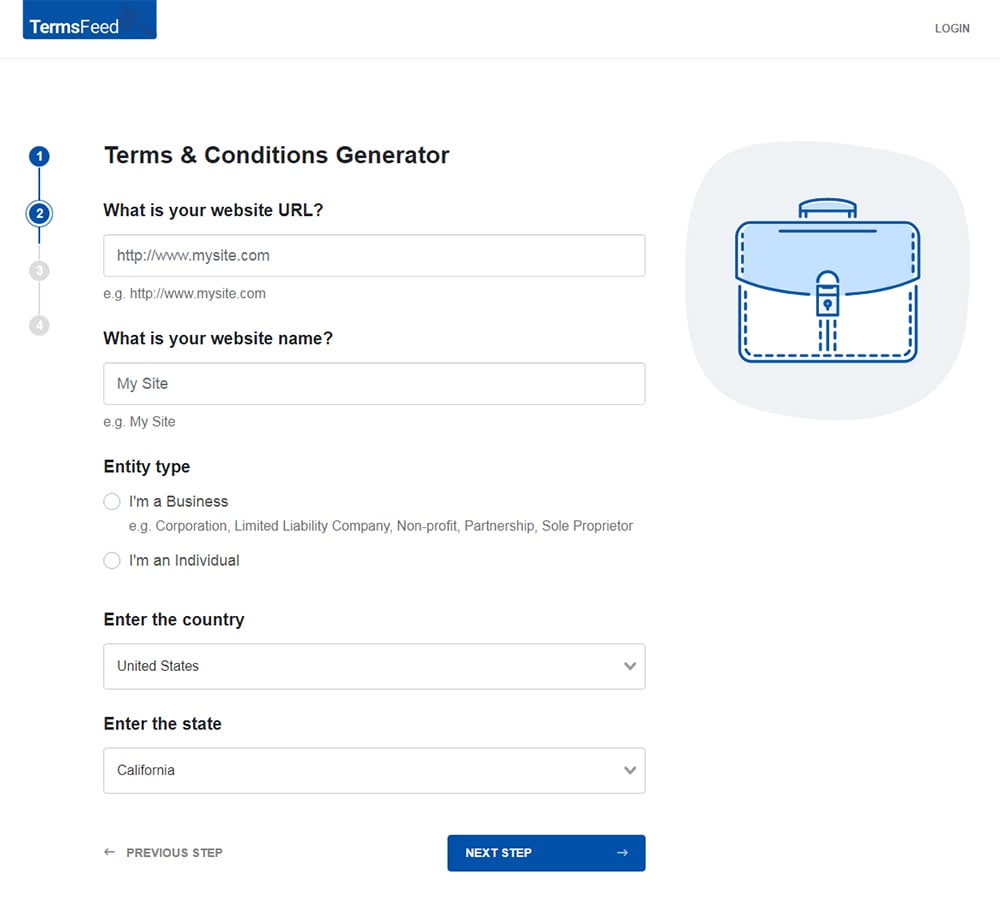
-
Answer some questions about your business.
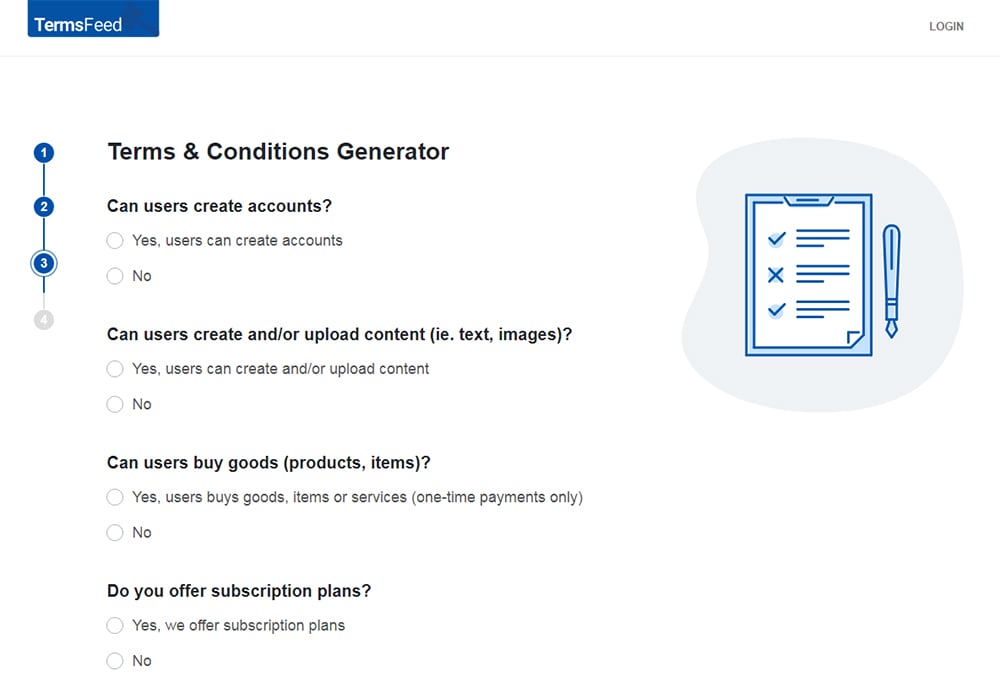
-
Enter the email address where you'd like the T&C delivered and click "Generate."
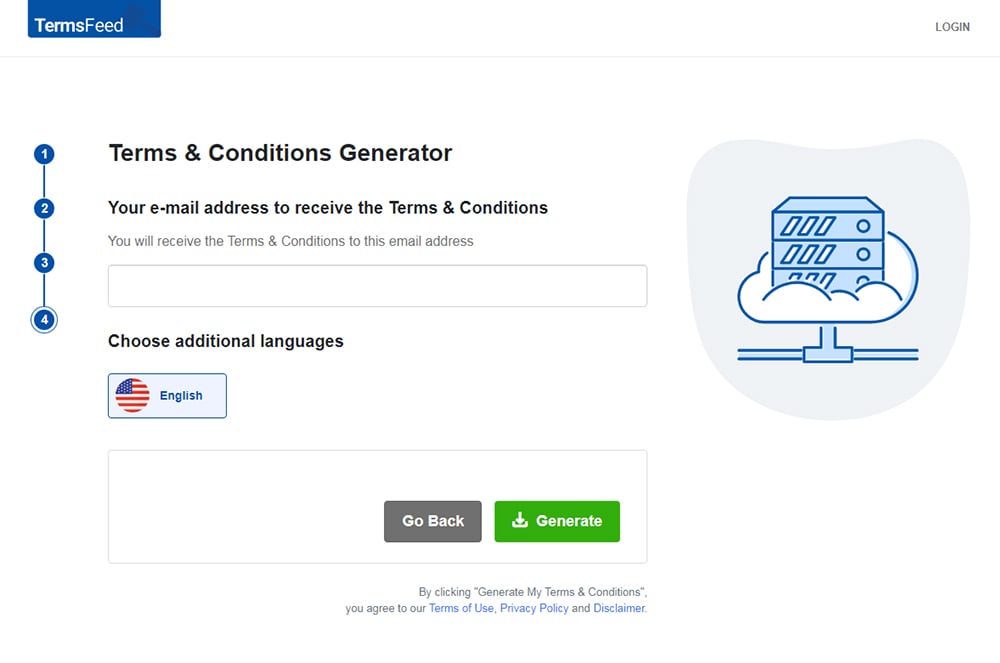
You'll be able to instantly access and download the Terms & Conditions agreement.
- 1. What is a Rules of Use Clause?
- 2. Why You Should Include a Rules of Use Clause
- 3. What Do You Need to Include in a Rules of Use Clause?
- 3.1. 1. No reverse engineering
- 3.2. 2. Users must not use or access the website in a way that could interfere with its availability and its services for other users
- 3.3. 3. Users must comply with applicable laws
- 3.4. 4. Users must not abuse or harm other users
- 4. Example Rules of Use Clauses
- 4.1. Apple
- 4.2. V Site
- 4.3. YouTube
- 4.4. Buy Me a Coffee
- 4.5. DLA Piper's CLE Library
- 4.6. Twitter
- 4.7. Huawei
- 5. Conclusion
What is a Rules of Use Clause?
A Rules of Use clause sets out the permitted uses of your website and what is expected of users. It details prohibited behavior that may result in a user being banned from your website.
These clauses are sometimes also called "User Rules," "User Guidelines," or "Acceptable Use Policy." Regardless of the title, these clauses outline what constitutes acceptable and unacceptable user behavior. And by getting users to agree to your Terms and Conditions agreement, you're getting them to agree to comply with these rules.
Why You Should Include a Rules of Use Clause
There are several reasons why it's useful to include a Rules of Use clause in a Terms and Conditions agreement.
Firstly, it sets out what users can and can't do on your website and the repercussions for breaching these rules. This gives you a basis to temporarily suspend or terminate the accounts of users who are in breach of the rules.
This clause aims to prevent any issues or disputes from arising by fully informing users about what is acceptable behavior on your website or platform. A Rules of Use clause can also help manage any legal issues or disputes that do arise and help you take action to resolve them.
A well-defined Rules of Use clause also enhances user experience. It encourages positive, respectful interactions between users of your website or platform and aims to prevent any interference with your website or platform that may disrupt user experience.
What Do You Need to Include in a Rules of Use Clause?

A Rules of Use clause should include:
- The effective date
- The specific rules your users must comply with
- What users can expect if they violate the rules
The exact inclusions in these types of clauses will vary according to your industry and specific business needs. You should draft a Rules of Use clause to suit your industry, product or service, business model, platform, and users.
You can write a Rules of Use clause in a style that fits with the tone of voice of your website or brand. The format of a Rules of Use clause is also up to you. Some websites include lengthy, bullet-point lists of specific examples of prohibited behavior, while others will outline what is unacceptable conduct in a few general, yet succinct paragraphs.
Regardless of the style, a Rules of Use clause should be clearly written in plain language so that your users can easily understand it. The main principle to keep in mind when preparing your website's Rules of Use clause is to make sure it's clear, reasonable, and lawful. This ensures it's legally binding and enforceable.
There are some standard elements of Rules of Use clauses that are frequently used across all industries. For example:
1. No reverse engineering
This clause prohibits users from extracting information from your website or service for the purposes of examining it to uncover a trade secret. Individuals can use this process to create a malicious copy of your website or service, or a program designed to undermine or interfere with it.
For example, the New York Times includes a prohibition against reverse engineering in the introductory paragraph of its prohibited use of the services clause:
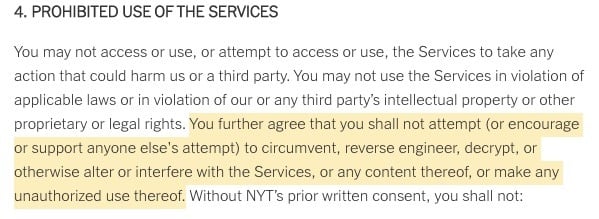
2. Users must not use or access the website in a way that could interfere with its availability and its services for other users
This prohibition restricts users from engaging in conduct such as hacking or the use of malware (software designed to steal a system's information) that affects the availability of the website. This restriction is closely related to the prohibition against reverse engineering and is often included in the same paragraph, as we can see in the above New York Times example.
In the below example from Zoom, the Rules of Use clause prohibits users from knowingly or negligently using the site in a way that interferes with or disrupts Zoom's network or its services:

3. Users must comply with applicable laws
This clause requires users to comply with the laws of the applicable jurisdiction. It may list specific categories of laws, such as intellectual property or criminal law, but this is ultimately a blanket requirement for users to not breach any laws when using the site or service.
For example, the requirement to comply with applicable laws is the first condition of LinkedIn's "Dos and Don'ts" under its User Agreement:
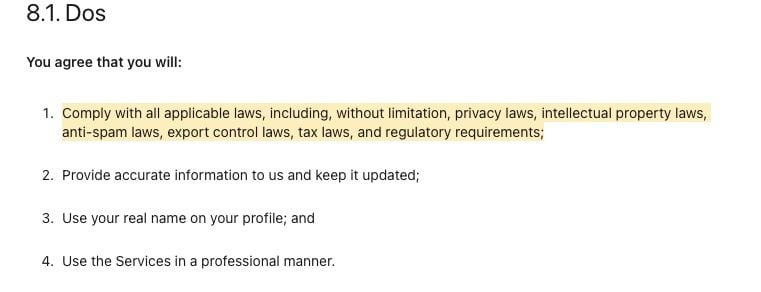
4. Users must not abuse or harm other users
Rules of Use clauses don't only regulate a user's interaction with your website or service. They also regulate conduct between users. As a starting point in their Rules of Use clause, many websites will prohibit abuse, bullying, or harassment of other users. Some websites refer to this as a Code of Conduct.
For example, Google's Terms of Service requires users to maintain a respectful environment and then specifically prohibits abuse or harm of others:
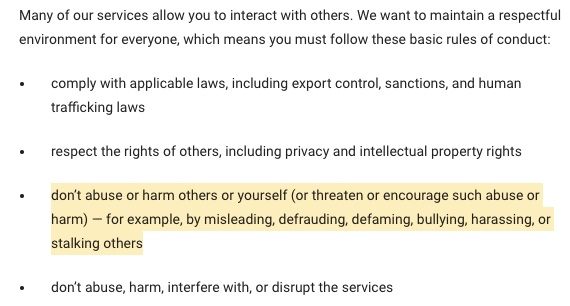
Now that we've seen a few examples of the basic components of this clause, let's take a look at some specific implementations of the clause by different businesses.
Example Rules of Use Clauses

Rules of Use clauses can take many forms. The level of detail, formatting, and exact rules will depend on your specific business needs, as you can see from the various examples below.
Apple
Apple includes a "Use of Site" clause in its Website Terms of Use. Over seven paragraphs, Apple describes what constitutes prohibited user behavior:
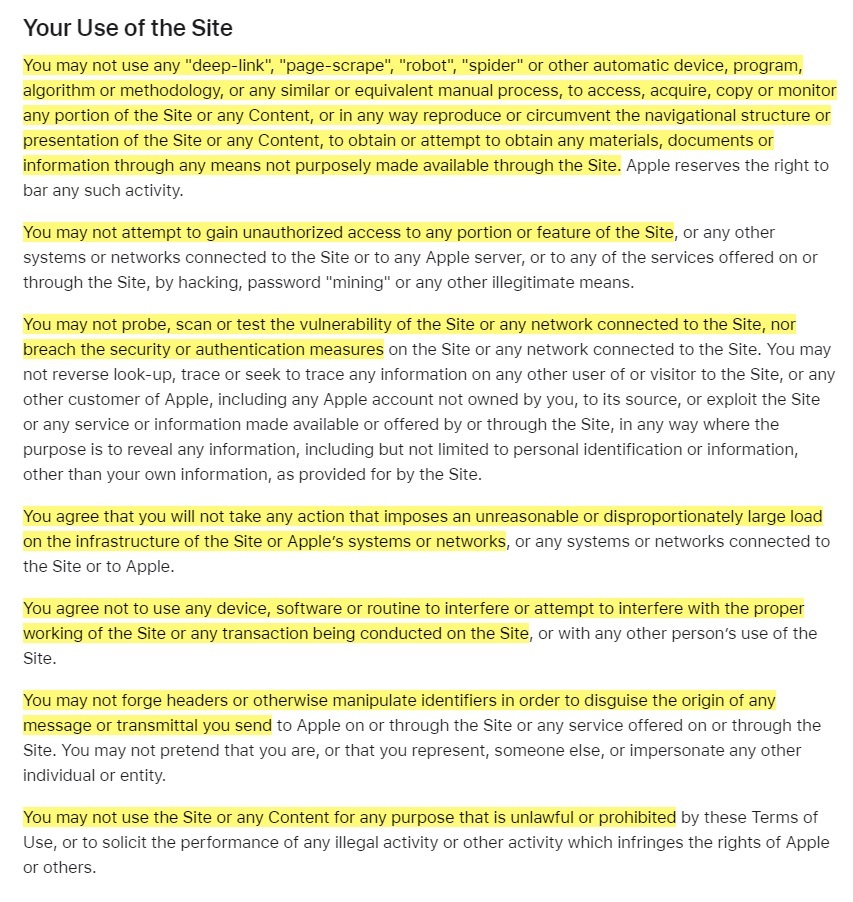
The breakup of each restriction into its own short paragraph helps make the clause more readable and easy to understand. While the clause is long, it's formatted in a way to make it more easily digestible.
V Site
The below example is from V Site, a UK-based company that certifies qualifications and work eligibility for worksite employees and contractors. It divides its Rules clause up into two sections: What users shall do, and what they shall not do:
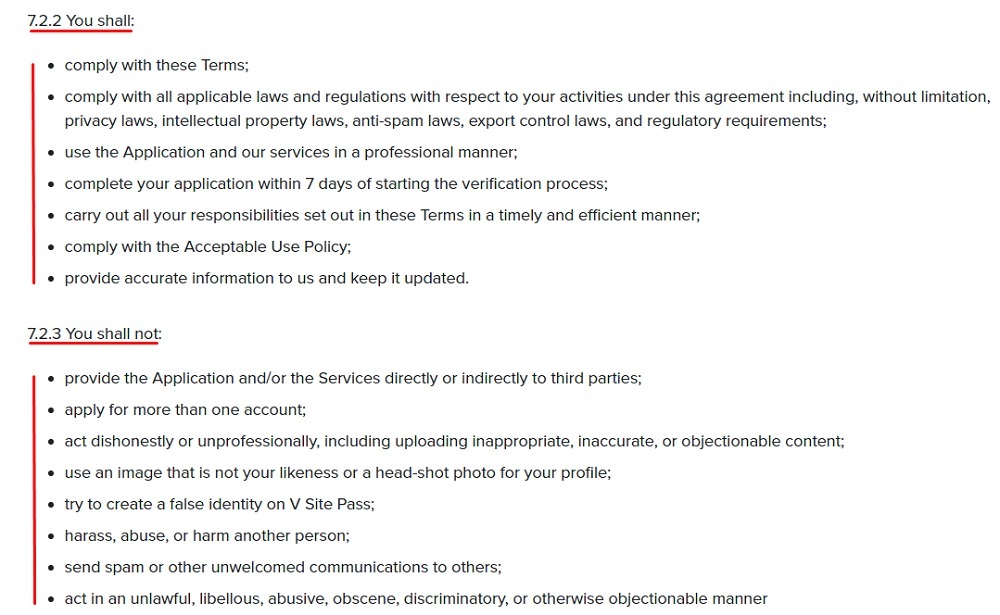
The use of bullet points makes both lists easy to read and understand. The dividing up of what users shall and shall not do helps to set expectations and make it clear not only what users cannot do, but what they can do.
YouTube
YouTube's Rules of Use are found under its Terms of Service > Your Use of the Service. It sets out the behavior YouTube prohibits, specific to the type of content (videos) available on its website:
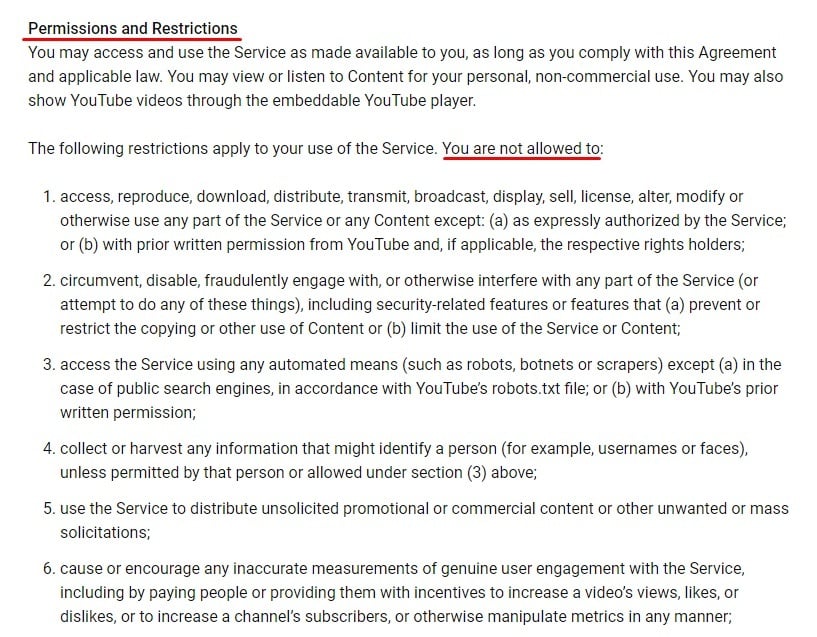
Having numbers in the list helps with readability and organization here.
Buy Me a Coffee
The below example is from Buy Me a Coffee, an online service that facilitates donations to support online creatives' work. It's a good example of a Rules of Use clause written in the brand's tone of voice. It avoids using any legalese, explaining what constitutes unacceptable use of the website and service with simple, straight-to-the-point language:
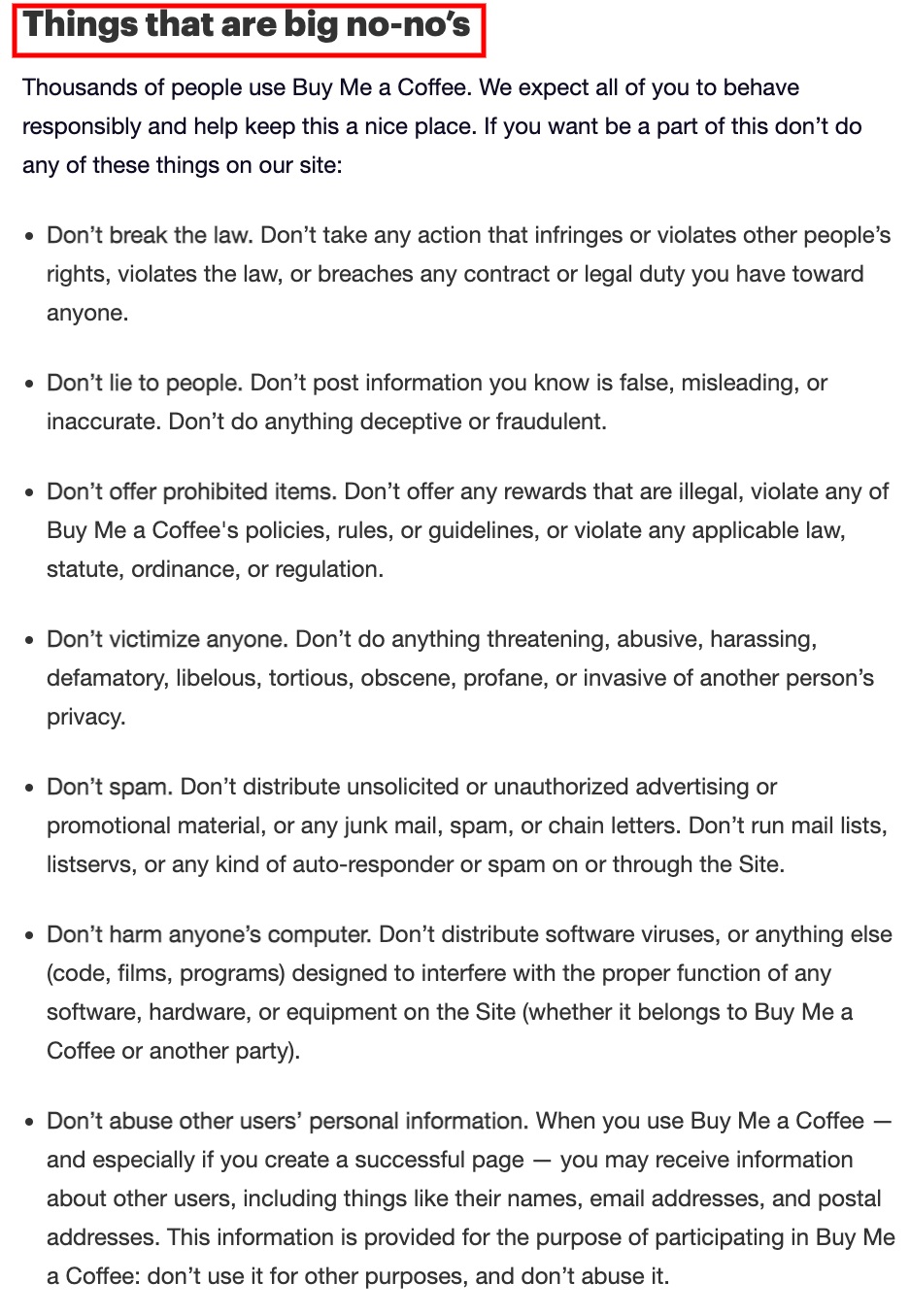
DLA Piper's CLE Library
In contrast, law firm DLA Piper's Rules of Use clause is written in a more legal style, reflecting the nature of the service it provides and relevant to its users:
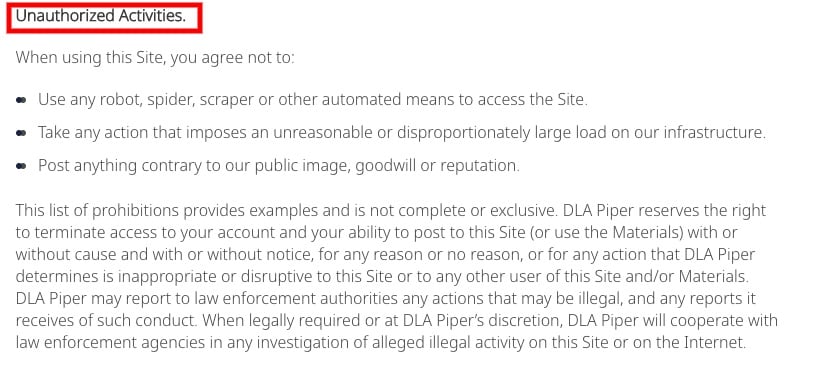
The "Twitter Rules" outline the platform's Rules of Use across three broad themes - safety, privacy, and authenticity. These rules are strongly orientated towards user engagement, given that's the focus of the service. Twitter presents these rules succinctly, with links to further information.
Here's the Safety section that has rules that relate to things like violence, harassment, illegal activities, adult content and hateful content.:
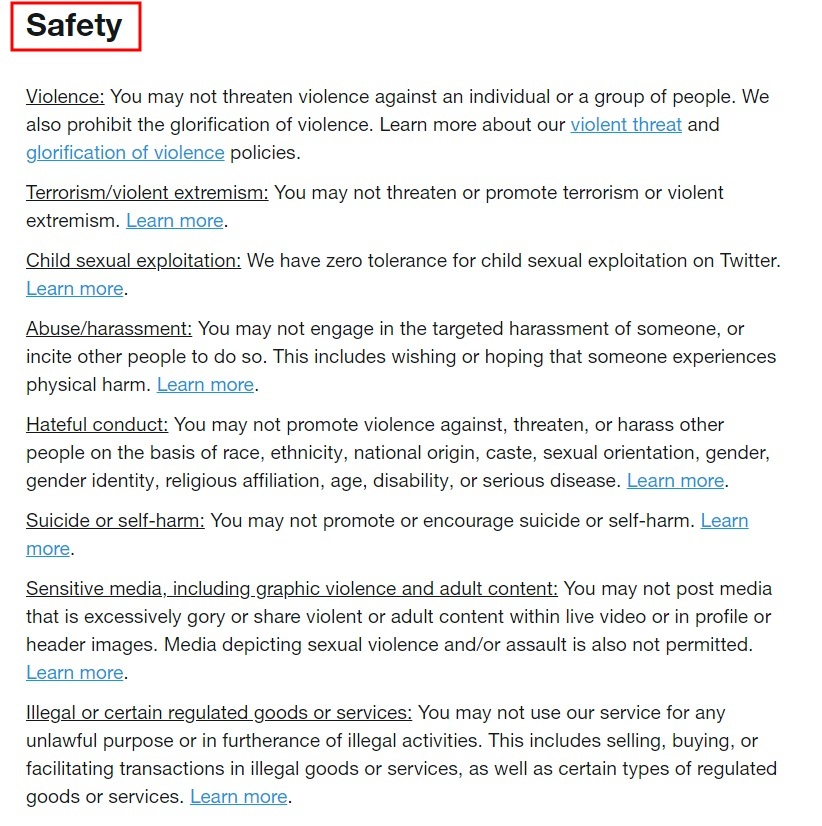
Here's the Privacy section that deals with the rules surrounding the use of people's private information and intimate content:
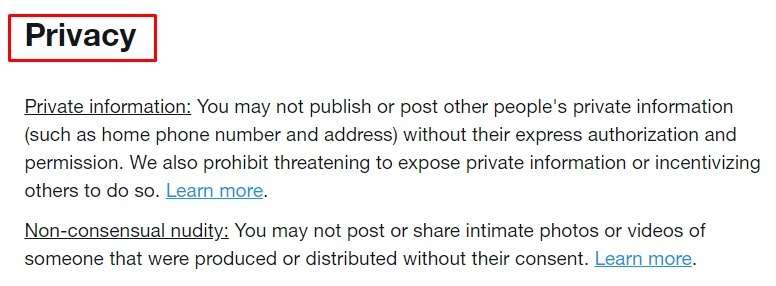
And finally, the Authenticity section deals with rules surrounding topics such as copyright and trademark rights, impersonation of others, spamming others and manipulating content to be deceptive:
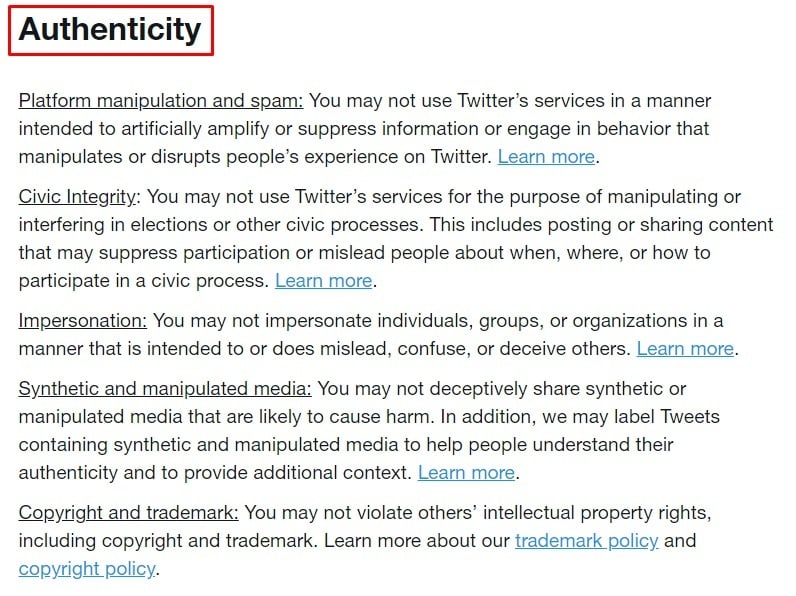
Huawei
Huawei describes its Rules of Use clause as "Usage Standards." Despite the different title, there are many of the standard inclusions in Rules of Use clauses including the prohibition against reverse engineering or interference with the website:
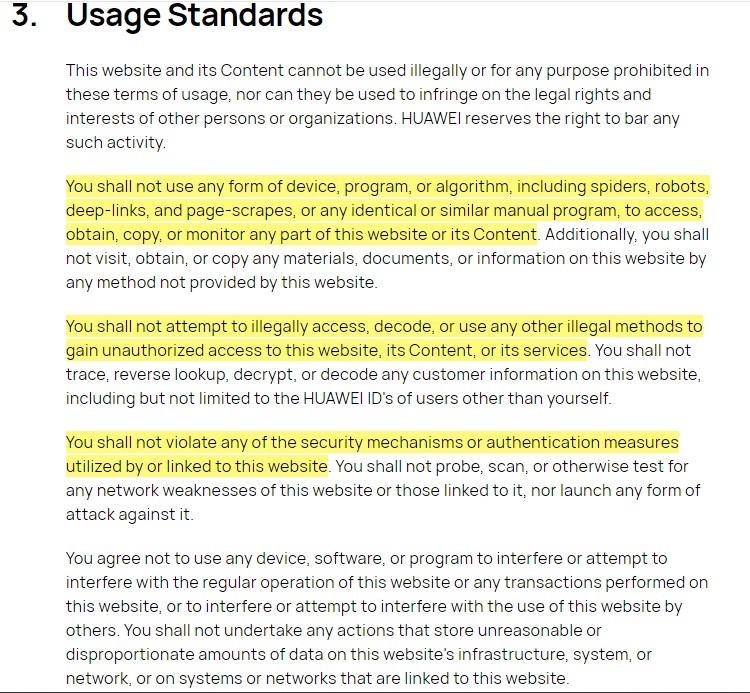
Conclusion
While a Terms and Conditions agreement isn't a legal requirement for your website, we strongly recommend having one and including a "Rules for Using our Site or Service" clause. A well-written Rules of Use clause is one of the best ways to protect your website or platform and your users against prohibited behavior by other users.
A Rules of Use clause clearly defines what is acceptable user behavior and gives you the basis to suspend or ban users in the event of a breach. You can decide what to include in your Rules of Use clause depending on your industry and business needs.
Remember to use clear language and formatting that breaks up the text to make the clause more readable and easy to understand.

Comprehensive compliance starts with a Privacy Policy.
Comply with the law with our agreements, policies, and consent banners. Everything is included.
